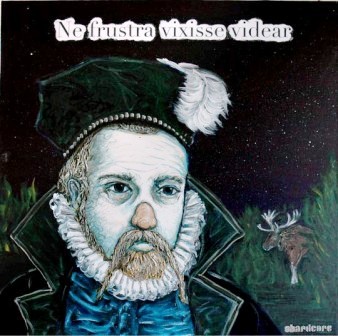 Long-time readers of WDTPRS know that I often post about astronomical phenomena.
Long-time readers of WDTPRS know that I often post about astronomical phenomena.
I was looking up a few things about astronomers and happened on some interesting tidbits on the false-nosed Dane, Tycho Brahe (+1601), interesting especially since I find news stories about moose to be amusing.
Yes… moose.
Amusing when they aren’t deadly.
By the way, as he was in extremis Tycho is thought to have uttered to Johannes Kepler the words "Ne frustra vixisse videar". Kepler came to work with Brahe in 1600. Ironically, after Brahe died the next year, the Copernican Kepler stole his data.
Now about that term "nova"… obviously Latin.
 Did you know that Tycho … really, Tycho Brahe had a pet moose?
Did you know that Tycho … really, Tycho Brahe had a pet moose?
Yes, indeed. At his castle, Landskrona, – Tycho was very rich – he kept a moose which followed him around, … along with a clairvoyant dwarf named Jepp.
Please no "white dwarf" jokes from you astronomers, this is serious.
But first, this is where the amusing part begins.
Tycho was going to lend his moose to a friend, a Landgrave, for a race against a reindeer to determine which was faster.
A question we often ask ourselves where I grew up, by the by. And to think I also have Danes in my family tree. Hmmmm… I digress.
Sadly, Tycho was unable to hold up his end of the race. The moose went to its untimely demise when it drank too much beer and fell down the stairs.
It may not have been so funny at the time, now that I reflect on it… but…
"But Father! But Father! ….. "
To my point.
Tycho, who wore a fake nose of metal after a little dueling problem, observed a bright unmoving star which was "new" in the sense that it did not conform to the ancient Aristotelian ideas of immutable heavens, etc: it suddenly appeared and got brighter, which in a perfect heaven shouldn’t have been happening!
What Tycho observed was Super Nova 1572 in Cassiopeia. It grew to be as bright as Venus!
Tycho wasn’t the first to spot the change to this new star, which brightened from 2-6 November 1572, but he was the one with whom it has ever after been associated because of his 1573 work De nova et nullius aevi memoria prius visa stella.
Thus, nova for an newly appearing star.
So, Tycho seems to have coined the term "nova" for this sort of star … though it may have been a Swiss named, I am not making this up, Fritz Zwicky.
SN 1572 faded again in 1574, leaving a pretty cool looking nebula.

No one can say that these guys weren’t interesting.


































Many moons ago when I was a student I passed by his grave countless times in a dark gothic cathedral with a huge wooden door and a dried up human hand hanging on a rope (I don’t know why)off to the right. If you’re ever in Prague go see the St. Vitus church and step into the 16th century: but then again, things may have changed, perhaps now it is packed with tourists. I am remembering a time when it was a solitary place and rarely would you find another soul inside.
Tycho was always one of my favorite astronomers to learn about in class and this was one of the most entertaining descriptions of his life I’ve seen! Fritz Zwicky…now there is an interesting fellow too: a great scientist who came up with the concept of dark matter and helped discover neutron stars, but I had professors who told stories their advisers told them about this infamous fellow at Caltech named Zwicky.
That was one of your more entertaining posts, Father. Keep up the good work! :-D
Ah . . . a post that barely makes any sense and yet shows us how moose are related to supernova! (Or not. :-D)
Now, what was I saying? Fr. Z — you definitely made science more entertaining than even my classes at school. Good job! Hope that you’ll do some more posts like this in the future!
Actually, it was only the bridge of his nose that was removed in the duel.
http://longstreet.typepad.com/thesciencebookstore/images/2008/04/09/tycho_brahe.gif
“Non haberi, sed esse” refers nicely to the nova.
The other night on the way to Adoration I saw 4 moose. One on my hill as I left my house. Then as I was leaving the parking lot at church, I had to exit the far entrance, because the moose blocking my regular exit. Then as I turned the corner, there were 2 eating behind the dentists building.
None of them did anything funny or amusing, except for the one in the parking lot ran across the street and almost ran into the house that was there because the driveway was slick and it couldn’t stop.
But Moose are quite deadly… we have signs in our town that display the number of moose hit on our roads around here since july… that number is at 139.
For some reason, everytime I see a moose, I think of Woody Allen’s classic routine, when he told how he hit a moose!
I heard that on my British Airways flights in 1989, when I went to England the first time by myself-I was listening to the in-flight entertainment system that compared British and American humor.
I like Tycho as well, especially his attempt to reconcile the Copernican and Ptolemaic systems (in Tycho’s idea, all the planets went round the sun but the sun went round the earth). He bequeathed his observations to Kepler in the hope that he would prove the validity of the Tychonic system.
Arthur Koestler (The Sleep Walkers) and Willy Ley (Watchers of the Skies) both describe this era in great detail. Ley in particular goes on to describe the travails of Galileo against Papa Barberini, his erstwhile friend. Reading this account, one gets the feeling that Galileo, impetuous and bad tempered, (though of course a scientific genius), managed to dig himself into the hole he eventually found himself. This is a rather different from the glib judgments put out by most commentators today, who are too anxious to push their own antipapist agenda.
In what may not be a coincidence, Fr — mentioned Kepler in his sermon today.
Also, Mr Brahe is buried in the Church of Our Lady before Tyn on Old Town Square in Prague. He was re-interred in the floor in 1901. There is a nice statue to him on the Epistle side near the altar rail just outside of the sanctuary.
The “hanging arm” tells quite a differnt tale and is in the Church of St James the Greater to the East and north of the Old Town Square Square. The arm hangs from an iron pipe above the Lady Altar. Legend has it that the arm once belonged to a thief who tried to steal money from the alms box, situated just below the statue of the Virgin. Our Dear Mother, put back by this blatant display of disregard for morals, grabbed the thieving arm and wouldn’t let go, such that it had to be amputated. The severed arm was (un)ceremoniously hung from the ceiling as a warning to other apprentice sinners.
Gives new meaning to the term “Poor Box John”, doesn’t it?